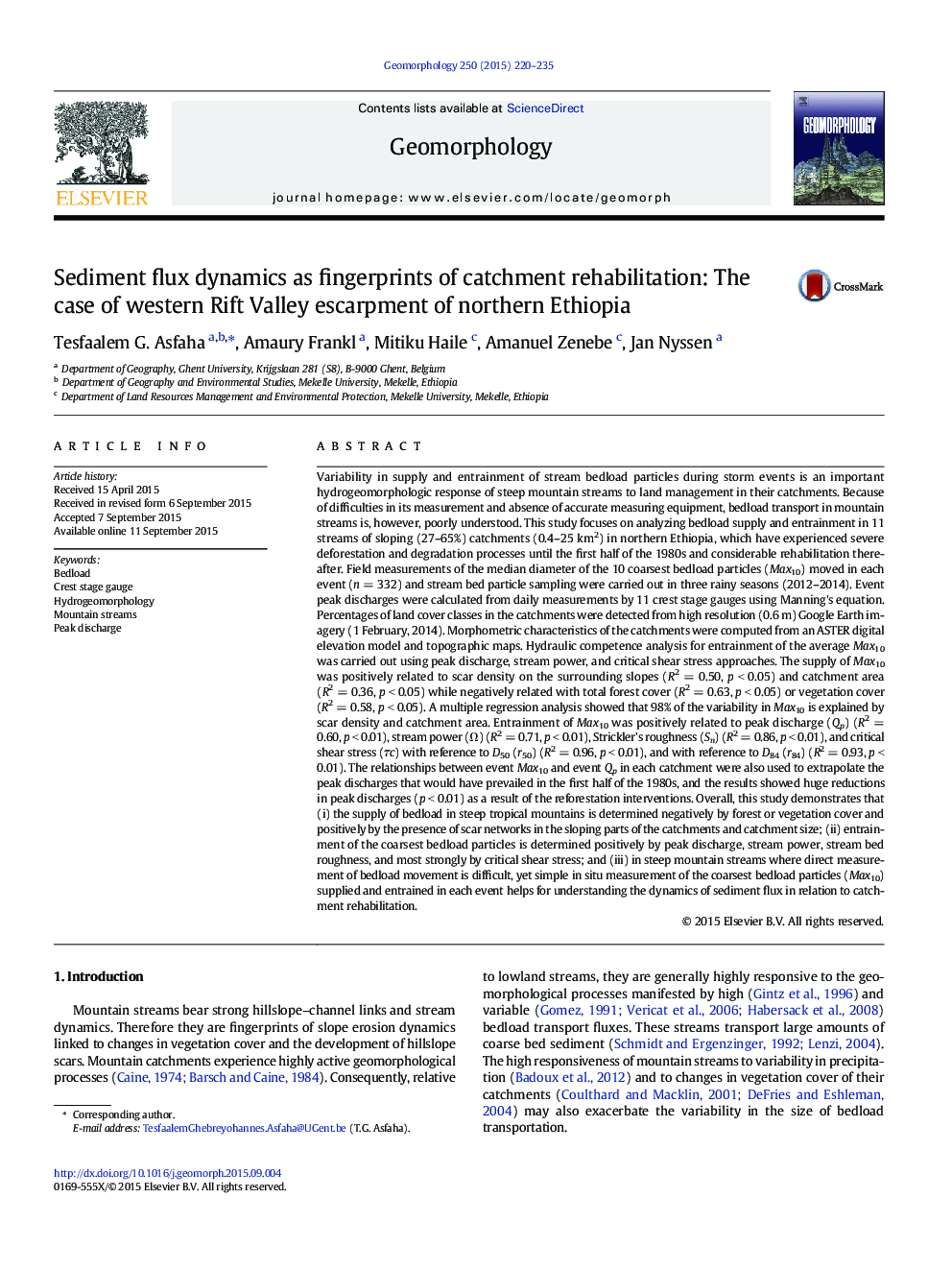| کد مقاله | کد نشریه | سال انتشار | مقاله انگلیسی | نسخه تمام متن |
|---|---|---|---|---|
| 6431797 | 1635399 | 2015 | 16 صفحه PDF | دانلود رایگان |
- The supply of bed load to streams is determined by vegetation and scar networks.
- Entrainment of bed load particles is determined by peak discharge, stream power and strongly by critical shear stress.
- Analysis of coarsest bed load helps for understanding the dynamics of sediment flux.
Variability in supply and entrainment of stream bedload particles during storm events is an important hydrogeomorphologic response of steep mountain streams to land management in their catchments. Because of difficulties in its measurement and absence of accurate measuring equipment, bedload transport in mountain streams is, however, poorly understood. This study focuses on analyzing bedload supply and entrainment in 11 streams of sloping (27-65%) catchments (0.4-25 km2) in northern Ethiopia, which have experienced severe deforestation and degradation processes until the first half of the 1980s and considerable rehabilitation thereafter. Field measurements of the median diameter of the 10 coarsest bedload particles (Max10) moved in each event (n = 332) and stream bed particle sampling were carried out in three rainy seasons (2012-2014). Event peak discharges were calculated from daily measurements by 11 crest stage gauges using Manning's equation. Percentages of land cover classes in the catchments were detected from high resolution (0.6 m) Google Earth imagery (1 February, 2014). Morphometric characteristics of the catchments were computed from an ASTER digital elevation model and topographic maps. Hydraulic competence analysis for entrainment of the average Max10 was carried out using peak discharge, stream power, and critical shear stress approaches. The supply of Max10 was positively related to scar density on the surrounding slopes (R2 = 0.50, p < 0.05) and catchment area (R2 = 0.36, p < 0.05) while negatively related with total forest cover (R2 = 0.63, p < 0.05) or vegetation cover (R2 = 0.58, p < 0.05). A multiple regression analysis showed that 98% of the variability in Max10 is explained by scar density and catchment area. Entrainment of Max10 was positively related to peak discharge (Qp) (R2 = 0.60, p < 0.01), stream power (Ω) (R2 = 0.71, p < 0.01), Strickler's roughness (Sn) (R2 = 0.86, p < 0.01), and critical shear stress (Ïc) with reference to D50 (r50) (R2 = 0.96, p < 0.01), and with reference to D84 (r84) (R2 = 0.93, p < 0.01). The relationships between event Max10 and event Qp in each catchment were also used to extrapolate the peak discharges that would have prevailed in the first half of the 1980s, and the results showed huge reductions in peak discharges (p < 0.01) as a result of the reforestation interventions. Overall, this study demonstrates that (i) the supply of bedload in steep tropical mountains is determined negatively by forest or vegetation cover and positively by the presence of scar networks in the sloping parts of the catchments and catchment size; (ii) entrainment of the coarsest bedload particles is determined positively by peak discharge, stream power, stream bed roughness, and most strongly by critical shear stress; and (iii) in steep mountain streams where direct measurement of bedload movement is difficult, yet simple in situ measurement of the coarsest bedload particles (Max10) supplied and entrained in each event helps for understanding the dynamics of sediment flux in relation to catchment rehabilitation.
Journal: Geomorphology - Volume 250, 1 December 2015, Pages 220-235
